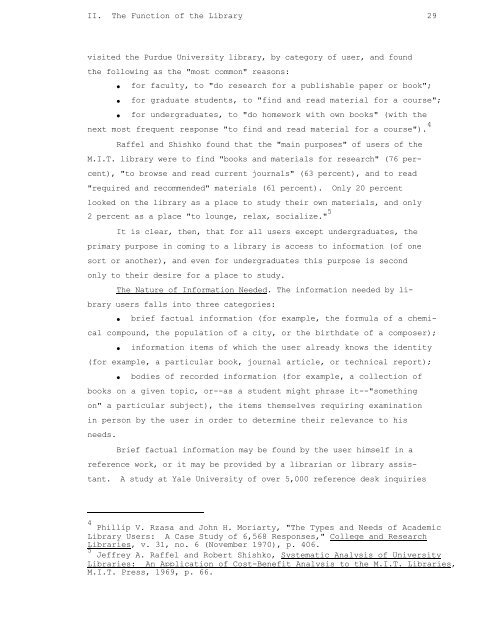The University of California Libraries: A Plan for Development (1977)
The University of California Libraries: A Plan for Development (1977)
The University of California Libraries: A Plan for Development (1977)
You also want an ePaper? Increase the reach of your titles
YUMPU automatically turns print PDFs into web optimized ePapers that Google loves.
II. <strong>The</strong> Function <strong>of</strong> the Library 29<br />
visited the Purdue <strong>University</strong> library, by category <strong>of</strong> user, and found<br />
the following as the "most common" reasons:<br />
• <strong>for</strong> faculty, to "do research <strong>for</strong> a publishable paper or book";<br />
• <strong>for</strong> graduate students, to "find and read material <strong>for</strong> a course";<br />
• <strong>for</strong> undergraduates, to "do homework with own books" (with the<br />
next most frequent response "to find and read material <strong>for</strong> a course"). 4<br />
Raffel and Shishko found that the "main purposes" <strong>of</strong> users <strong>of</strong> the<br />
M.I.T. library were to find "books and materials <strong>for</strong> research" (76 percent),<br />
"to browse and read current journals" (63 percent), and to read<br />
"required and recommended" materials (61 percent). Only 20 percent<br />
looked on the library as a place to study their own materials, and only<br />
2 percent as a place "to lounge, relax, socialize." 5<br />
It is clear, then, that <strong>for</strong> all users except undergraduates, the<br />
primary purpose in coming to a library is access to in<strong>for</strong>mation (<strong>of</strong> one<br />
sort or another), and even <strong>for</strong> undergraduates this purpose is second<br />
only to their desire <strong>for</strong> a place to study.<br />
<strong>The</strong> Nature <strong>of</strong> In<strong>for</strong>mation Needed. <strong>The</strong> in<strong>for</strong>mation needed by library<br />
users falls into three categories:<br />
• brief factual in<strong>for</strong>mation (<strong>for</strong> example, the <strong>for</strong>mula <strong>of</strong> a chemical<br />
compound, the population <strong>of</strong> a city, or the birthdate <strong>of</strong> a composer);<br />
• in<strong>for</strong>mation items <strong>of</strong> which the user already knows the identity<br />
(<strong>for</strong> example, a particular book, journal article, or technical report);<br />
• bodies <strong>of</strong> recorded in<strong>for</strong>mation (<strong>for</strong> example, a collection <strong>of</strong><br />
books on a given topic, or--as a student might phrase it--"something<br />
on" a particular subject), the items themselves requiring examination<br />
in person by the user in order to determine their relevance to his<br />
needs.<br />
Brief factual in<strong>for</strong>mation may be found by the user himself in a<br />
reference work, or it may be provided by a librarian or library assistant.<br />
A study at Yale <strong>University</strong> <strong>of</strong> over 5,000 reference desk inquiries<br />
4 Phillip V. Rzasa and John H. Moriarty, "<strong>The</strong> Types and Needs <strong>of</strong> Academic<br />
Library Users: A Case Study <strong>of</strong> 6,568 Responses," College and Research<br />
<strong>Libraries</strong>, v. 31, no. 6 (November 1970), p. 406.<br />
5 Jeffrey A. Raffel and Robert Shishko, Systematic Analysis <strong>of</strong> <strong>University</strong><br />
<strong>Libraries</strong>: An Application <strong>of</strong> Cost-Benefit Analysis to the M.I.T. <strong>Libraries</strong>,<br />
M.I.T. Press, 1969, p. 66.
















